December 8th, 2007 by Susan
Well I’m back into it (Paths) and back into the problems as well. It’s almost as if I need to sever all the links I’d originally formed in order to relink the way I’d like the story to open up.
One of my main problems seems to be the one between stories–the same problem I’ve been working on from the beginning and did a workaround with guard fields. Well the guard fields won’t work because 1) they feel too restrictive to the reader and 2) if a reader has come from a different path, they won’t stop him here anyway.
I’m trying to plan something around using more text-links. One thought is to create a complete path weaving through all the stories via the normal click on space, along with a story thread of clicking on the text-link of the last word in almost every space.
I’m getting confused and think that cutting all links might be the best way to start back at the near beginning.
Posted in PROJECTS, STORYSPACE | Comments Off on STORYSPACE & PROJECTS: Link Steps
December 8th, 2007 by Susan
It’s great to have the laptop running again; that adds just about all the hours that I’m either in the shop or watching TV to the time I can spend on Storyspace and Paths.
With the network set up to include files and folders, I can work on the single ‘shared’ version of Paths and save copies on each computer as I work.
I’ve gotten just about a quarter of the way through the narrative, tying in the stories and wandering off onto other trails as I go, but this takes a lot of plotting and planning. Just don’t know if it’s worth it with this particular project but I can’t exactly leave it now as it is. Thinking of starting something new as well, just to keep the interest and enthusiasm up since drudge work often can taint the creative spirit.
Back in a bit.
Posted in PROJECTS, STORYSPACE | Comments Off on STORYSPACE & PROJECTS: Back to Easy Access
December 7th, 2007 by Susan
Sort of limited in what I can do on Paths because I’m down to the main PC. Without the laptop, I can’t work on it while working in the shop or watching TV. That cut down considerably on when, much less be in the mood as well.
But the screen for the laptop came today and maybe either tonight or in the morning I’ll be able to put it together.
In the meantime, there’s some stuff going on at Steve Ersinghaus’ place with hypertext presentation.
Posted in PROJECTS, STORYSPACE | Comments Off on STORYSPACE & PROJECTS: Plodding Along
December 6th, 2007 by Susan
Thinking about changes this morning. Fat and funerals–but that I’ll post on Spinning. Here I do still refer to Spinning because of a picture I put into the sidebar there. It looks like this:

It’s of me, and I stuck it in as the banner for one day only just to scare people. That was before I brought it into Photoshop and made it look like it does above and restuck it into the sidebar after coming up with a new logo banner.
But what it makes me think about is the cartoonization of man. I’ve posted here before about the TV commercials that use animation clearly based on reality format. It’s a world where we’re doing all we can to dehumanize humanity. Easier, faster means of communication such as cellphones, text messaging, e-mails, and yes, weblogs. We’re putting more and more barriers between skins. Applebee’s (restaurant) commercials now have a talking apple but it tells a human to drop the text messaging and get together in real life with his friends over a meal. Does the apple foresee an even more open yet barren of touch existence?
I am me, and yet I am a cartoon. This sheds so much more light on the graphic novel as an art form. It also relates to an essay called Transitioning that I did back in New Media class.
It’s a different world out there. And ‘in here’ grows more solitary and secured.
Posted in NEW MEDIA | Comments Off on NEW MEDIA: Cartoonization
December 5th, 2007 by Susan
My thanks again to Steve Ersinghaus for reminding me of the way to take screen shots in Windows so that I can not only add visual examples to this journal of how I wandered into Storyspace, but can share them on this weblog format (he also introduced me to blogging).
While none will see the copybook I also have kept as I’m writing this story, I am making sure that anything of any importance as to exploration and discovery is written about here.
Don’t know who reads this, but even if it’s just for myself, I have a complete record of the progress of the project, even–in old postings that I have to find and replace after wiping them off the weblog in a hissy fit–the very beginnings of Paths that was done as a "pseudohyperfiction" form. Via Copy & Paste, I’ve transferred all the posts into a Word.doc so that I can, as I did with New Media, print out a hard copy of all this as well.
That, I suppose, is where the traditional mingles with the new. Just like me.
Posted in STORYSPACE | Comments Off on STORYSPACE: The Journal and The Journey
December 5th, 2007 by Susan
I’m just beginning really, but this is already so much better than before. This narrative form of “wholeness” — looking at the big picture you might say–is already improving the plot structure of Paths. Below is the new linkage that leads to what I’ll still call Story #4:
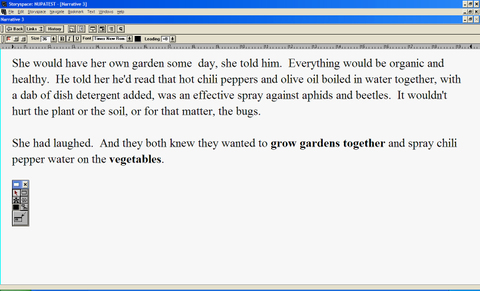
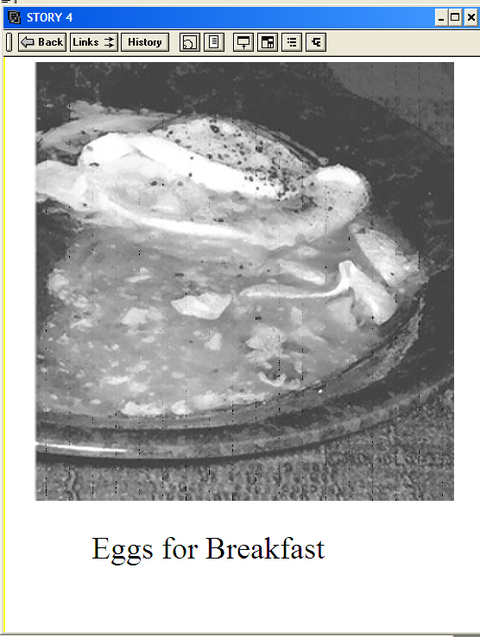
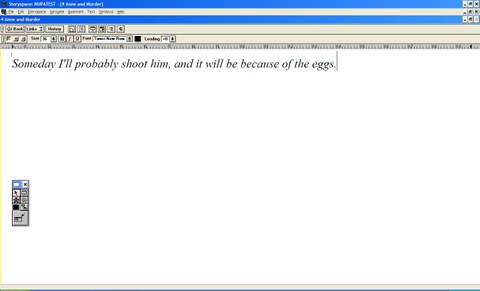
Posted in STORYSPACE | Comments Off on STORYSPACE: Structure – YES!
December 4th, 2007 by Susan
Just a note here on what I’d like to see featured into any upgrades to the Windows version of Storyspace.
First and desperately needed is that "Do you want to save your work before you close?" box that is available in the Mac version but not in Windows. That just would remove so much of the fear of inadvertantly closing and losing between saves (as well as free up a couple pages of warnings in the manual). Though to be honest, it appears that if the program is inadvertently closed, when reopened it does look very similar to how it was closed–but that may just be because I’d recently ‘saved’ anyway.
Another almost imperative change would be the "promote children" command that’s again available in the Mac version only. This would have prevented an awful lot of hand-picking and rearranging for me in getting the Map View the way I later realized I needed it to be the best workable format. In so doing, it leads to the third area of concern.
Making the Map View make sense has affected the other Views. Now the Chart View is rather messed up but this depends on height of box on the view, etc. and I’m not sure that anything can be done to coordinate them. I think you need to decide which View you’re going to work with and stick with it regardless of what it does to the appearance of the others.
Overall, it’s an excellent and effective tool for hypertext writing. It’s user friendly, extremely easy to use and manipulate, and the manual has extremely good coverage and clear instruction. What the creators couldn’t realize at the time is how it affects the writer’s technique and style in composing narrative. This is likely an individualized benefit though I’m sure that much of it is shared in writer experience. And it’s all good.
Posted in STORYSPACE | Comments Off on STORYSPACE: Technical Notes
December 4th, 2007 by Susan
Going back to Steve’s posting last night regarding the knowledge of character as influenced by environment, I agree completely that Storyspace, by its technical aspects of Writing Spaces and Mapping does bring an opportunity to develop characters in a different manner than traditional writing style.
What Steve terms as knowledge I might call faceting as well (why does Watchmen come to mind?). Visually, the Writing Spaces are acting as windows, or a “tell me everything about yourself in thirty seconds” to the writer. They are answers to the “oh, that’s why he did that,” about a character. They form natural breaks of paragraph and thought, often encouraging another window to open, just as often pulling the shade down as a conclusion to a question. The writer is being encouraged to question any sequence of the narrative as it unfolds. He can then share what he learns via a loop or thread of Writing Spaces.
The Spaces also influence the pacing of story. Just as short sentences increases dramatic action, the spaces allow a rat-a-tat-tat of information or a slow revelation of a hidden spirit.
In the manner of a new acquaintance, we find out bits and pieces of our characters by their thoughts, their actions, enclosed in separate boxes that are ever-ready to hold this secret or that.
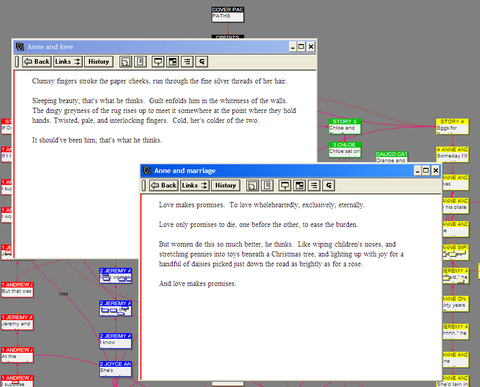
Posted in STORYSPACE | Comments Off on STORYSPACE: Character Development
December 4th, 2007 by Susan
Went to bed. The thought wouldn’t go away. Does structure of narrative indicate anything of the personality of an author?
We see this in literature all the time, the influence of the experience of the writer on the story. But with the maps and charts of Storyspace, do we see more, even as we propose the means of hypertext as a more reader based work?
I can’t sleep because of the strictness of the five rows of story, evenly spaced, color-coded. What have I revealed about myself? Anal retentive? I am hoping for logical and organized if such things can be determined from Storyspace’s Map View at all.
A thought creeps in, my salvation, perhaps: The stories will be connected to the mainline and each other in loops. It is in my power to arrange the writing spaces to reflect that, as one story flows from the main path, travels a bit and returns, only to lie dormant for a few more spaces until it flows outward again. This Map View would look more like a blade of swamp grass with bubbles of frog eggs billowing out down its length. And I will look more free-spirited. That is, if I can take myself out of square.
Posted in STORYSPACE | Comments Off on STORYSPACE: Personality
December 4th, 2007 by Susan
This is a portion of the latest Map View where I have all five trails laid out side by side (with just a few of the ‘children’ or side trails pulled out) and this, I think, is where I’ll find it easiest to work with link connections. It will also allow for the expansion of story and character that seems to be a phenomenon of the Storyspace environment not as easily offered or noticed in traditional writing methods (or at least by me). Steve notes this element in his post on Hypertext and Character. (Semantically proper link here!)
What this particular structure has already allowed me to do is find a starting point in the central narrative for each of the four paths to begin. Since the entire reading layout will now be focused on a single starting point that includes the interweaving of the four (instead of the prior separation of starting points with random connecting links), where the stories touch and interplay with each other is a matter of locating natural ‘touching’ points of narrative. Sort of like one thought sparking another.
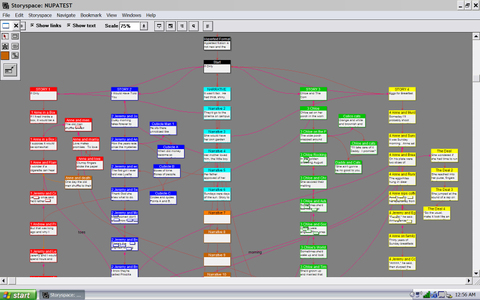
Posted in STORYSPACE | Comments Off on STORYSPACE: All Paths Lead Home







 The Lost Children: A Charity Anthology
The Lost Children: A Charity Anthology